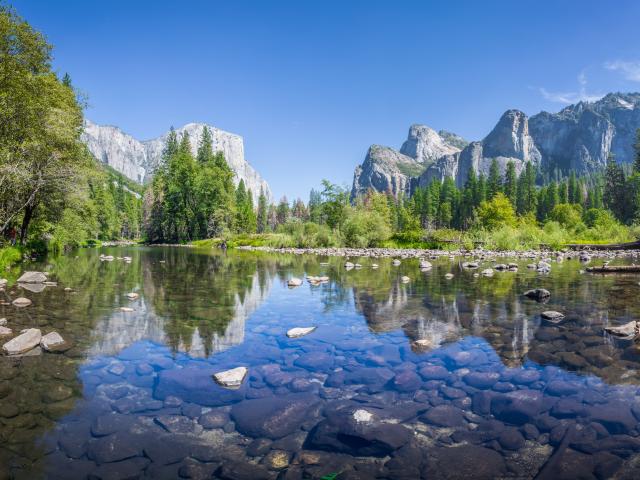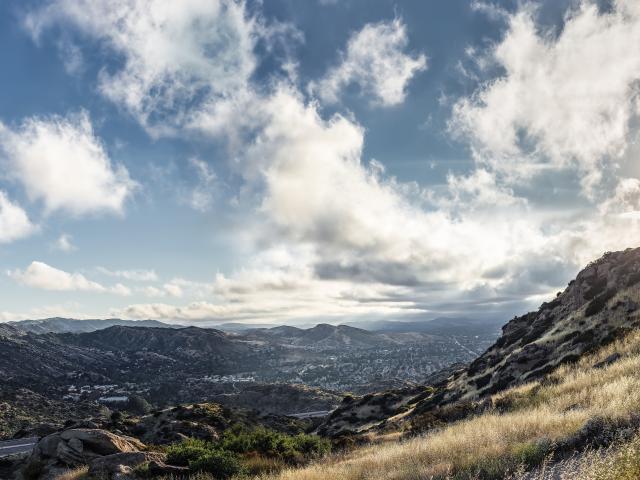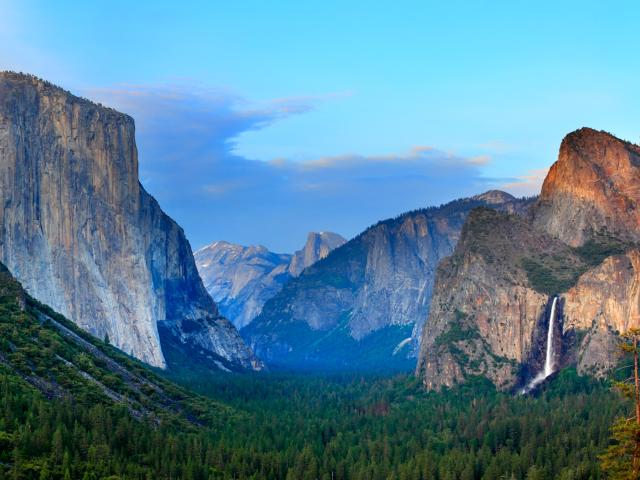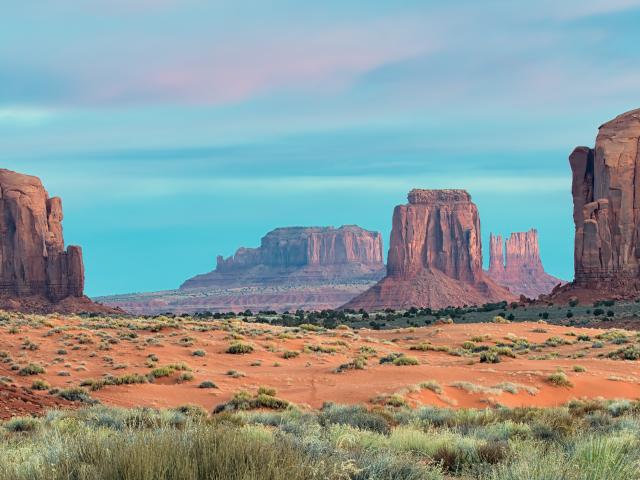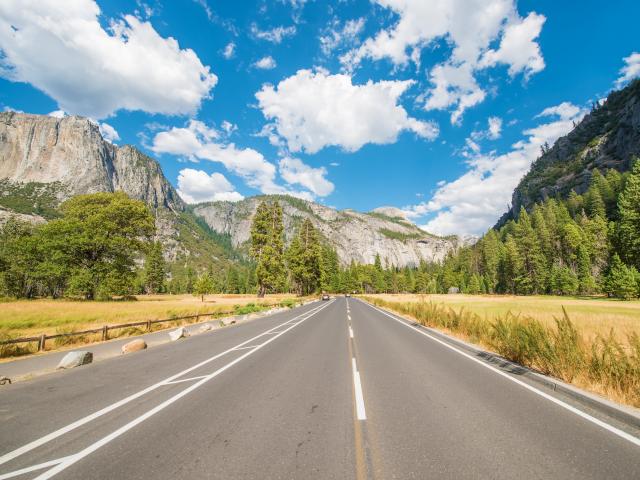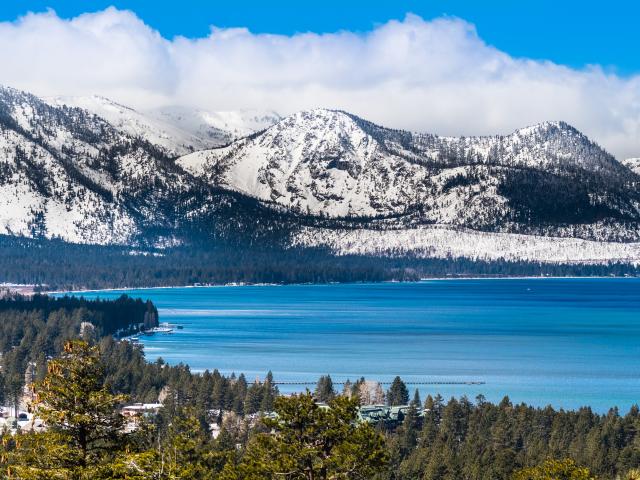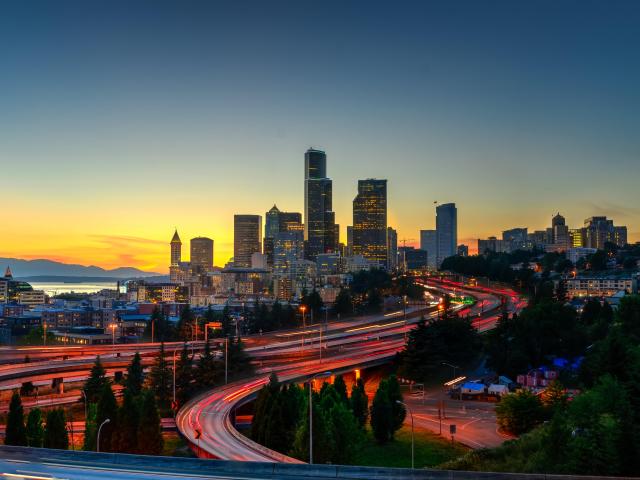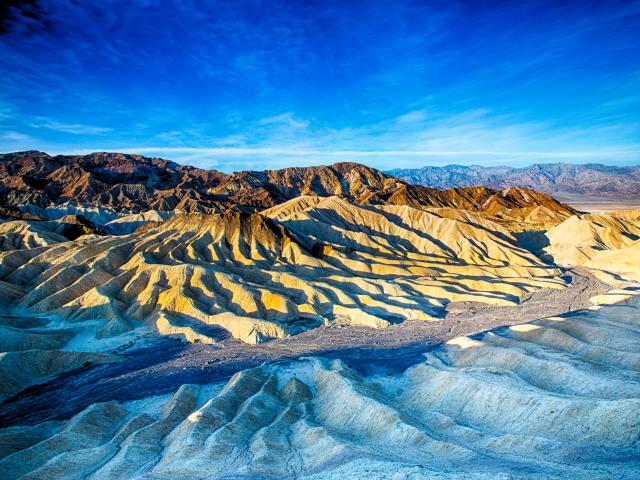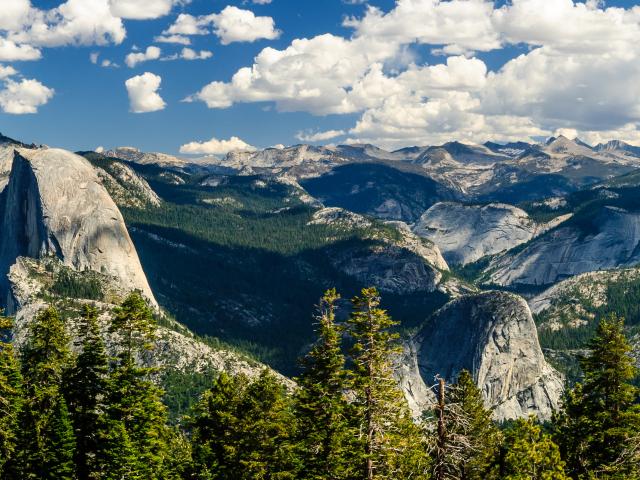Where should I go after Yosemite? 11 amazing ideas for the next stop on your road trip!
The mountain landscapes and iconic waterfalls of Yosemite National Park are a highlight of many trips to California, and you can easily fill an entire trip exploring its scenic views. If you are hungry for more afterwards, you are in luck! Yosemite is close to some of the world's famous cities and magical sights.
On our list of 11 amazing places to visit after Yosemite, you will find stunning national parks from Sequoia National Parks and Death Valley to Lake Tahoe. Alternatively, if you are looking for urban fun, there are many iconic cities near Yosemite.
Whether you're looking for a short add-on or an epic road trip to round off your stay in Yosemite National Park, you have plenty of options to choose from. Keep on reading to find out more about our top picks, including how to get there, what to see, and some of the highlights to keep you entertained along the way.
Below you will find a list of amazing destinations from Yosemite and what makes each adventure special.
Where to go after Yosemite
| Place | Distance / Time | Highlights |
|---|---|---|
| Lake Tahoe | 190 miles / 4 hours | Offers stunning alpine scenery and crystal-clear waters, perfect getaway in both summer and winter |
| Los Angeles | 420 miles / 8 hours 10 minutes | A colorful urban experience with its iconic Hollywood culture, beautiful beaches and theme parks |
| San Francisco | 260 miles / 5 hours 20 minutes | Postcard-perfect city its iconic Golden Gate Bridge and vibrant cultural scene and coastal views |
| Grand Canyon National Park | 690 miles / 11 hours | Majestic canyon views, waterfalls, colorful geological formations, and amazing hiking opportunities |
| Las Vegas | 460 miles / 7 hours 25 minutes | A city of neon lights and entertainment, with endless casinos, luxurious hotel and dining options |
| Yellowstone National Park | 800 miles / 12 hours | The first national park in the world, famous for its geothermal wonders and wildlife |
| Redwood National Park | 520 miles / 10 hours 50 minutes | Home to the towering ancient redwoods, presenting a serene and majestic forest experience |
| Monterey and Carmel-by-the-Sea | 210 miles / 4 hours 20 minutes | Boasting breathtaking coastal views and charming towns, offering a picturesque seaside escape |
| Death Valley National Park | 350 miles / 6 hours 20 minutes | Known for its extreme heat and striking desert landscapes, salt flats and stones that move on "their own" |
| Sequoia National Park | 140 miles / 2 hours 30 minutes | Famed for its gigantic sequoia trees, presenting a forested wonderland home to General Sherman Tree |
| Lassen Volcanic National Park | 360 miles / 7 hours | Features unique volcanic landscapes and hot springs; a unique geothermal adventure |
1. Lake Tahoe
4 hours from Yosemite (190 miles)
Why you should visit Lake Tahoe: Lake Tahoe's alpine scenery, featuring clear lake views and majestic snow-capped mountains, makes for an unforgettable outdoor escape. Just 4 hours from Yosemite, it's a year-round destination.
In summer, sandy beaches around the pristine alpine lake are popular with swimmers, and you can head out boating or kayaking on the lake too. The surrounding mountains are famous for skiing and snowboarding in winter.

How to get from Yosemite to Lake Tahoe: Use the Big Oak Flat Entrance to leave Yosemite National Park and follow CA-120 to Chinese Camp. From here, US-49 will take you past Montexuma, Sonota, and San Andreas as you travel north.
Switch to US-50 past Diamond Springs, driving northeast until you reach Lake Tahoe.
What to expect on the drive from Yosemite to Lake Tahoe: This 4-hour road trip takes you through stunning mountain scenery, past small towns where you'll find hiking trails and lookouts towards the snow-capped peaks.
After leaving Yosemite National Park you'll come to Groveland, a small historic town with old shops and restaurants and a convenient stop where you can stock up with supplies for the drive, before continuing towards Lake Tahoe.
After a drive on the Golden Chain Highway, you'll find Sonora, CA. Dip into the boutique shops, art galleries, and restaurants of this mesmerizing Gold Rush-era town, while you admire the Historic District's Victorian architecture
Our highlights: One of the best ways to experience Lake Tahoe is to take a leisurely drive right around the shores. Along the way, you'll find viewpoints and charming lakeside towns to explore, or take a boat cruise to appreciate the clear waters and surrounding mountains from a different perspective.
One of our top picks for places to stop as you travel around Lake Tahoe is Emerald Bay State Park. From this popular hiking spot, which is also home to historic Vikingsholm Castle, you can follow a trail to an elevated vantage point for panoramic views of the lake.
Even if hiking isn't high on your priority list, you can still head up the hillside to admire the view on the Heavenly Mountain Gondola. In winter, Heavenly Mountain Resort becomes Lake Tahoe's ski and snowboard hub.
Further around the lake, you'll find shops, restaurants, and scenic tram rides in the charming village of Squaw Valley. The resort hosted the 1960 Winter Olympics, so expect expert ski slopes here too.
Did you know? Lake Tahoe is the second deepest lake in the United States behind Crater Lake. It reaches a depth of 1,645 feet.
2. Los Angeles
8 hours 10 minutes from Yosemite (420 miles)
Why you should visit Los Angeles: Los Angeles is a vibrant city where you can immerse yourself in the world of entertainment. As well as being home to major TV and film companies centered around Hollywood, it's also where you'll find movie-focused amusement parks including Disneyland and Universal Studios.
As an added bonus, head west from Yosemite to Los Angeles and along the way you'll enjoy a stunning drive along the Pacific Coast Highway - its iconic ocean views are unforgettable!

How to get from Yosemite to Los Angeles: Use the South Entrance of the National Park to head south out of Yosemite and drive through Fresno. Past Lemoore, start heading towards the shore, and you will soon drive through Paso Robles.
From Morro Bay, your drive will take you on the iconic Pacific Coast Highway as you travel past San Louis Obispo, Pismo Beach, Solvang, Santa Barbara and Malibu on the shore before you arrive at Los Angeles.
What to expect on the drive from Yosemite to Los Angeles: The drive from Yosemite to Los Angeles is a great way to experience California's changing landscapes. In Santa Barbara you'll find historic Mediterranean-style white buildings, reflecting the city's Spanish heritage.
If time allows, stop off to see Mission Santa Barbara too, which was founded in 1786.
The Pacific Coast Highway is a highlight of this road trip. Pull over at the regular viewpoints to admire the rugged coastline and sparkling ocean waves.
Then as you approach LA, spend some time in Malibu. Known for its sandy beaches and celebrity homes, you can also relax at Zuma Beach and Malibu Beach.
Our highlights: The road trip from Yosemite to Los Angeles is the perfect combination of coastal experiences and city vibes. At Morro Bay you'll find Morro Rock, a volcanic mound on the beach which forms a great backdrop for stunning photos, especially at sunset.
In Solvang, you'll feel like you've been transported all the way to Denmark. With distinctive Danish architecture, cuisine, and boutique shops, Solvang is a unique Californian destination.
Heading back to the water's edge, embrace the vibrant atmosphere at the historic Santa Monica Pier. You'll find an amusement park, aquarium, bars and restaurants.
For iconic views of the LA skyline, head to Griffith Observatory once you've arrived in the city. It's also a great place for a close-up look at the iconic Hollywood Sign.
Did you know? The iconic Hollywood sign is a symbol of the entertainment industry. But did you know it was first erected in 1923 as a commercial for a local real estate development?
READ MORE - Road Trip from Yosemite to Los Angeles
3. San Francisco
5 hours 20 minutes from Yosemite (260 miles)
Why you should visit San Francisco: San Francisco is real melting pot of cultures, known for iconic landmarks including the Golden Gate Bridge, Alcatraz Island, and Fisherman's Wharf.
Take the time to tour the City by the Bay's electric neighborhoods, where you can discover international cuisine and immerse yourself in a whole world of art, fashion and museums.

How to get from Yosemite to San Francisco: Similar to the road trip above, you will use the South Entrance as you leave Yosemite and then follow CA-41 and then CA-152 west to reach the shore and connect to Pacific Coast Highway.
Drive through Santa Cruz on this legendary road and keep following the Pacific coastline until you reach Half Moon Bay. From here, CA-92 and then US-101 will take you to the heart of San Francisco.
What to expect on the drive from Yosemite to San Francisco: The route from Yosemite to San Francisco involves a stretch of Pacific Coastal Highway known for its epic coastal routes, which is perfect if you're ready to enjoy the contrast between Yosemite's mountain landscapes and the sparkling blue ocean.
You can drive from Yosemite to San Francisco in half a day, so spend a couple of hours in Santa Cruz, where you can walk along the vintage boardwalk with its historic rides, and shops for vintage clothes on Pacific Avenue.
If time allows, stretch your leg at Half Moon Bay State Beach too, where there are some gorgeous hiking trails.
Alternatively, in the summer you can drive a more direct route that avoids the coast. Joining Big Oak Flat Road off Tioga Road means you can take the trip from Yosemite to San Francisco in just over 3 hours, but keep in mind that Tioga Road closes during the winter months until May or June.
If you'd like to learn more about how you can adjust which entrance to use depending on the season, here is our guide on all the entrances of Yosemite National Park.
Our highlights: There's so much to explore in San Francisco that it's hard to pick out just a few highlights. Golden Gate Park is a must-see if it's your first time in the city - once you've snapped a shot of the famous Golden Gate Bridge, take some time to enjoy the rest of this urban oasis, where you'll find gardens, museums, and lakes.
Fisherman's Wharf is another popular spot. The bustling waterfront area is a great place to enjoy seafood, shops, and attractions. When you're ready to take a trip across the water, pick up a ferry to Alcatraz Island to explore the notorious former prison and discover its history.
San Francisco is home to one of the oldest and largest Chinatowns in North America. Sample the cuisine and browse the Chinese Cultural Center. Alternatively, for hipster culture, the Mission District is a vibrant neighborhood with a creative ambiance.
Did you know? The City by the Bay has microclimates. Varying weather conditions occur in the different neighborhoods at the same time!
READ MORE - Road Trip from Yosemite to San Francisco
4. Grand Canyon National Park
11 hours from Yosemite (690 miles)
Why you should visit Grand Canyon National Park: The sheer size of the Grand Canyon will take your breath away. It's an iconic natural phenomenon and one of the Seven Natural Wonders of the World.
From viewpoints around the mile-deep canyon you can look down and marvel at the power of nature, admiring the changing colors of the intricate layers of rock which reach right down to the Colorado River below.
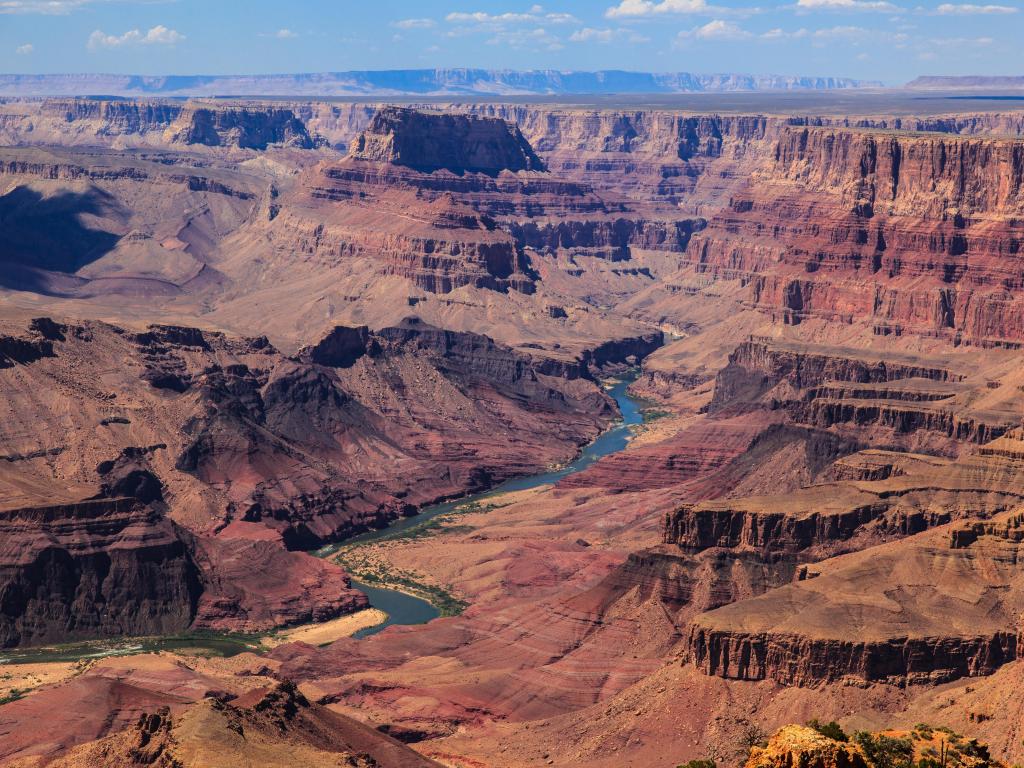
How to get from Yosemite to Grand Canyon National Park: After your visit to Yosemite National Park, use the South Entrance and follow CA-41 and CA-99 heading north through Fresno and Bakersfield. From here, you will use CA-58 to merge onto I-40 past Barstow.
Visit Mojave National Preserve and then Kingman, known for its Route 66 heritage, and the interstate will then take you all the way east to Williams, which you can use as a gateway as you visit the majestic Grand Canyon National Park.
What to expect on the drive from Yosemite to Grand Canyon National Park: You'll get to tick off some iconic road trip destinations when you travel between Yosemite and the Grand Canyon.
From Bakersfield, the landscape will eventually turn into arid desert, so consider a slight detour off I-40 to Lake Havasu City too cool down with some water sports in the desert sun.
You'll also pass Kingman, AZ, which is the perfect place to explore some historic Route 66 landmarks and immerse yourself in charming small-town vibes.
Our highlights: The Grand Canyon's South Rim is the most accessible way to visit the national park and the starting point on your trip from Yosemite.
At the South Rim you'll find many of the Grand Canyon's iconic viewpoints, as well as Grand Canyon Village and many visitor facilities including the Grand Canyon Railway.
There are many outstanding overlooks around the vast Grand Canyon but for an unobstructed canyon vista with breathtaking sunsets, head for Hopi Point.
Carry on to Yavapai Point to visit the Yavapai Geology Museum for insightful information on the canyon formation and also enjoy views of the canyon and Colorado River.
For the most scenic viewpoints, here is our detailed guide on the best photo spots in Grand Canyon National Park.
If you're feeling active, there are countless trails that head around or into the Grand Canyon. Explore trails like Bright Angel Trail, Trail of Time, or South Kaibab Trail for canyon views removed from the crowds.
Did you know? The Grand Canyon is so big, it's larger than the state of Rhode Island. The park measures around 1,904 square miles. On the other hand, Rhode Island is just around 1,212 square miles.
5. Las Vegas
7 hours 25 minutes from Yosemite (460 miles)
Why you should visit Las Vegas: Las Vegas is the 'Entertainment Capital of the World', famous for its casinos and luxurious resorts. The casinos and hotels have unique themes, each with extravagant amenities and crazy architecture, perfect for sightseeing and some memorable photos as you explore the city.
As the sun begins to set, you'll find world-class entertainment when you visit the lavish shows and dazzling casinos along the famous Strip - the Las Vegas nightlife is unlike anything else you'll experience.
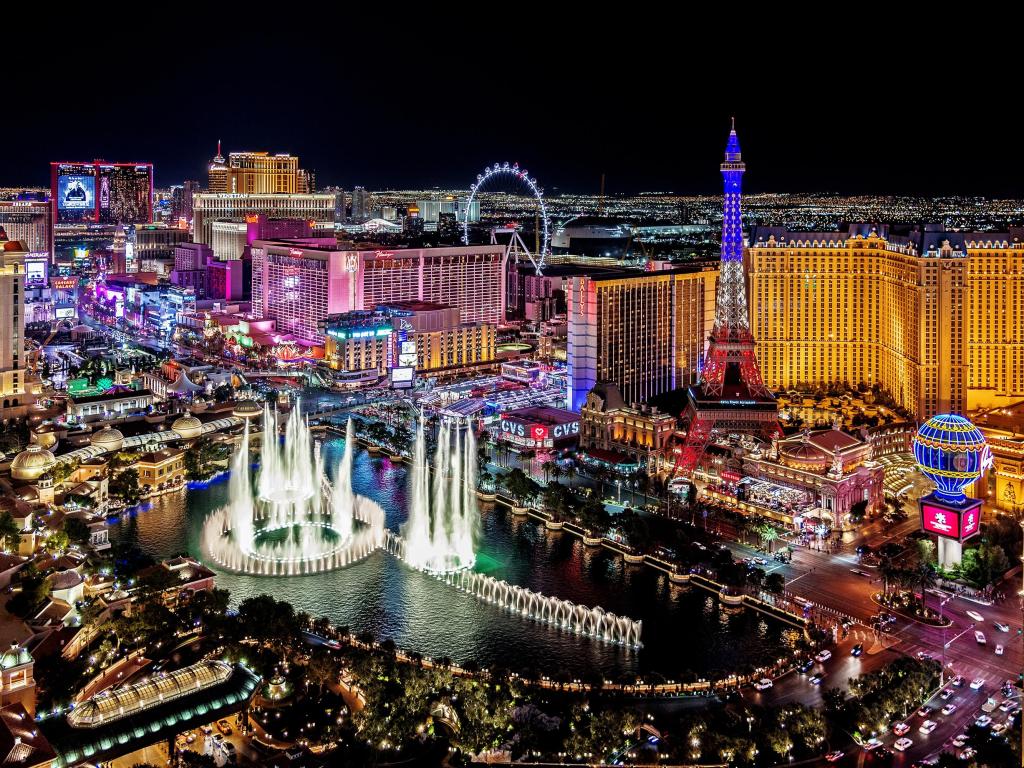
How to get from Yosemite to Las Vegas: Use the South Entrance to exit the national park and head south past Fresno and Bakersfield. Past Bakersfield, hop onto CA-58 and then Interstate 15 (I-15) to visit Mojave National Preserve. The interstate will then take you all the way to Sin City.
What to expect on the drive from Yosemite to Las Vegas: Head south out of Yosemite on Wawona Road and in a little over an hour you'll reach Fresno, where you can see the historic Tower District and visit the Forestiere Underground Gardens.
Continuing south, your route takes you through Bakersfield. Check out the vibrant arts scene here, and if time permits, visit the Buck Owens Crystal Palace.
As you bear west and start to make for the California-Nevada border, you'll spend most of the rest of the drive to Las Vegas crossing the Mojave Desert. As you might expect, conditions get very hot in summer so always travel prepared.
Approaching Las Vegas, traffic gets heavy on the Strip. Arrive on a weekday and outside of peak hours if you can, or leave extra time to avoid sitting on the interstate with your destination so tantalizingly close.
Our highlights: You'll cross the Mojave Desert as you drive from Yosemite National Park to Las Vegas - an unforgettable road trip experience.
Head to Mojave National Preserve and hike the expansive desert to really immerse yourself in the impressive landscape, after making sure you're prepared for the intense conditions you can encounter there.
A complete contrast to the desert, the Las Vegas Strip is a bucket list must-see. You'll find world-famous hotels, casinos, and dazzling neon lights here. What's more, the famous Strip is a very walkable area in the city, too. You can find our walking itinerary in Las Vegas here.
Make sure you catch the famous Bellagio Fountains show, when the impressive water feature dances to music. It's even more spectacular at night, when the lighting enhances the experience.
An alternative to the Strip is the Fremont Street Experience. The Downtown district is often considered the original Vegas, but these days you can use the zipline to fly above the street.
Did you know? Las Vegas is also home to bizarre museums. The Neon Museum is an outdoor exhibition with a collection of nostalgic neon signs that once adorned the strip.
READ MORE - Road Trip from Yosemite to Las Vegas
6. Yellowstone National Park
12 hours from Yosemite (800 miles)
Why you should visit Yellowstone: If you've caught the national park bug on your trip to Yosemite, why not follow up with a road trip to mighty Yellowstone? Known for its geothermal wonders, Yellowstone is actually home to half of the geysers in the world, including the iconic Old Faithful.
The rugged mountains and glacier-carved valleys of Yellowstone National Park are also home to a variety of wildlife. Visitors can sometimes see grizzly bears, wolves, and bison as they explore the park.
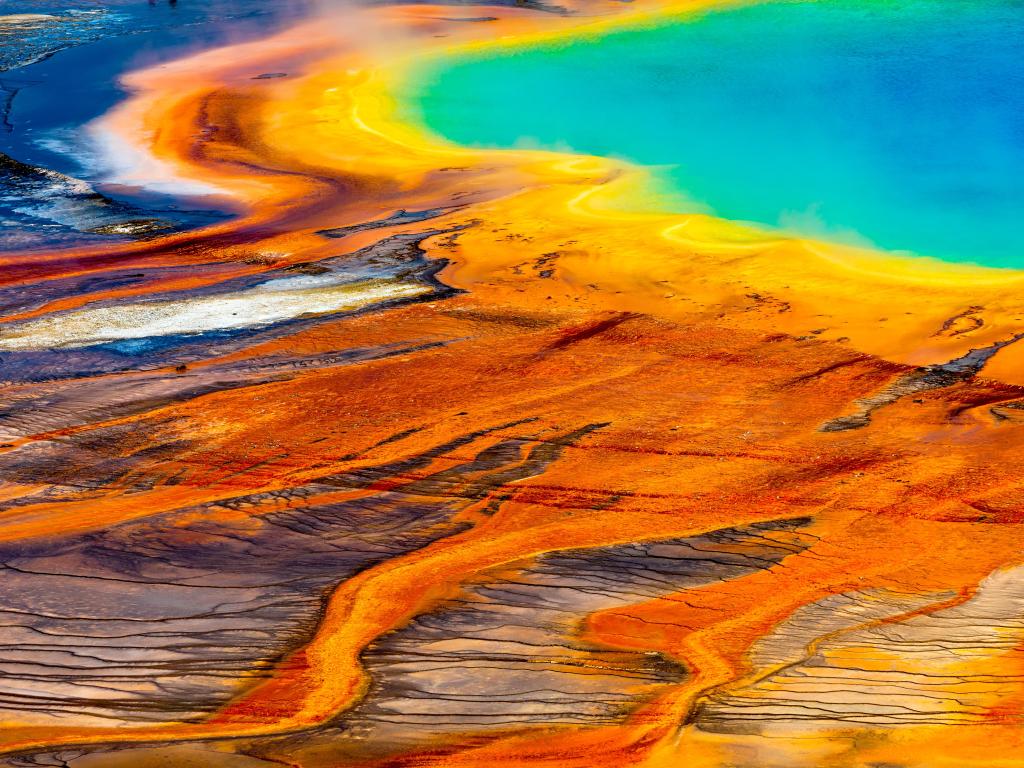
How to get from Yosemite to Yellowstone: Use the Tioga Pass Entrance to leave Yosemite. and head northeast past Le Vining and Mono Lake. You will soon cross from California to Nevada and drive to Battle Mountain to merge onto I-80.
Switch to US-93 past Wells and drive into Idaho and through Twin Falls. From here I-84, I-86 and then I-15 will take you to Idaho Falls. Keep heading north on US-20 from here and you will arrive at West Yellowstone, one of the best gateways to Yellowstone National Park.
Please note that the Tioga Pass Entrance is closed in winter and you will have to use another exit. Please see our detailed guide on the entrances to Yosemite National Park to help you plan your winter route.
What to expect on the drive from Yosemite to Yellowstone: The drive between Yosemite and Yellowstone is a great road trip, with plenty to see and do along the way.
Leaving Yosemite at Lee Vining, you can stop at Mono Lake Tufa State Natural Reserve to enjoy the vistas of Mono Lake before continuing north towards Yellowstone.
Your journey takes you through Idaho, where you can visit Shoshone Falls, also known as the 'Niagara of the West'. Then hike the sprawling forests of Caribou-Targhee National Forest before arriving at Yellowstone.
Our highlights: Old Faithful is a must-see for visitors to Yellowstone - luckily it gets its name because of its reliable and regularly timed eruptions, so you shouldn't have to wait too long to witness the famous spectacle.
For another geothermal experience, head to Grand Prismatic Spring. At its widest point, the vibrantly colored Grand Prismatic is 370 feet across, making it one of the largest hot springs in the USA.
The scenic Beartooth Highway is the perfect way to admire Yellowstone's impressive mountain landscapes. This All-American Road is lined with mountain views. To learn more about this drive, you can find our guide on where Beartooth Highway starts and ends here.
Then head to Grand Canyon of the Yellowstone to marvel at the fascinating geology of the canyon and its iconic Lower Falls.
Did you know? Established in 1872, Yellowstone was the world's first national park. It's considered a pioneer and paved for the national park system around the world.
READ MORE - Road Trip from Yosemite to Yellowstone National Park
7. Redwood National Park
10 hours 50 minutes from Yosemite (520 miles)
Why you should visit Redwood National Park: The coastal redwood trees of Redwood National Park are some of the tallest trees on Earth, creating a serene setting and an almost other-worldly atmosphere.
You can hike or take a scenic drive through the redwood forests along the Pacific Ocean coastline. For nature lovers and city dwellers looking to escape the hustle and bustle, it's a tranquil setting to relax and get in touch with nature.
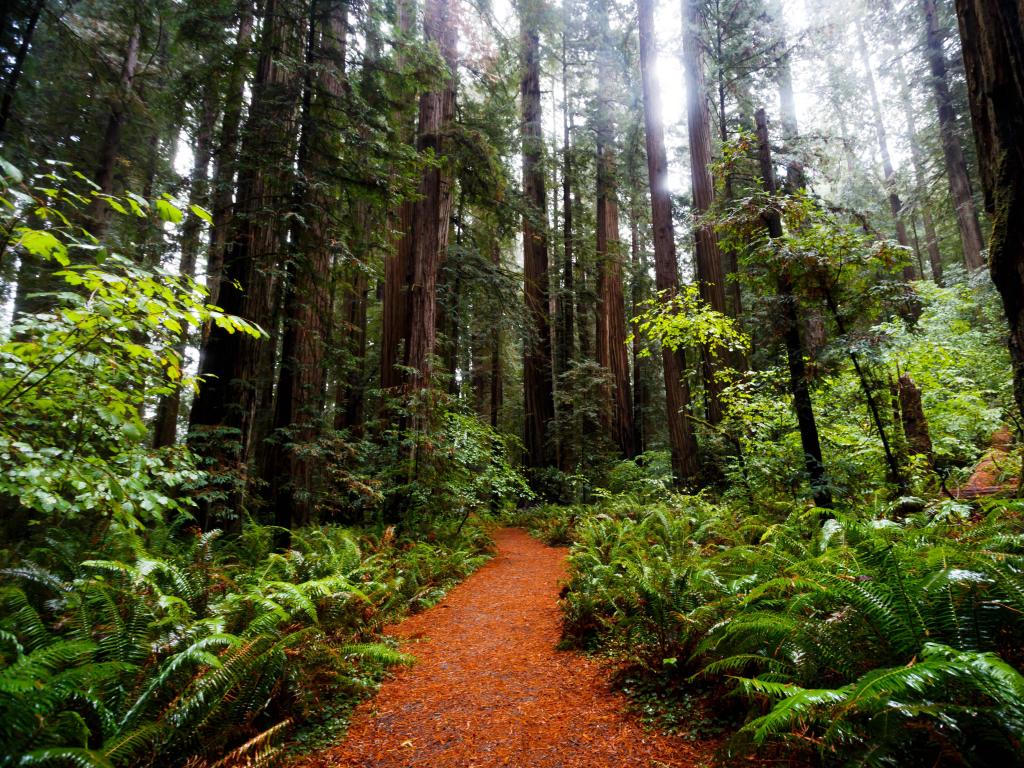
How to get from Yosemite to Redwood National Park: Exit Yosemite via the Big Oak Flat Entrance and follow CA-120 west. Past Manteca, you will hop onto I-5, I-205 and then I-580, which will take you through Oakland into San Francisco.
Follow US-101 from here and head to the shore to merge onto Pacific Coast Highway past Bodega Bay. Drive through Salt Point State Park, Point Arena, Fort Bragg and Leggett. US-101 will then take you past Eureka and Trinidad before you arrive at Redwood National and State Parks.
What to expect on the drive from Yosemite to Redwood National Park: The route from Yosemite to Redwood National Park includes a drive along the Pacific Coast Highway, with plenty of opportunities to stop and admire the view.
You'll also visit San Francisco en route, where you can enjoy landmarks such as the Golden Gate Bridge, Fishermen's Wharf, and Alcatraz Island. Or spend the afternoon hiking between coastal views at Salt Point State Park before watching the sun go down in style over the Pacific.
Our highlights: The Pacific Coast Highway gets more wild and rugged as it heads north towards Oregon, with some stunning beaches and towns to explore along the way.
Visit the state park in Manchester, CA, where you can camp close to the water and wake to the coastal views. Or head to the quaint seaport of Eureka and visit the Old Town to discover its charming Victorian houses.
Once you've arrived at Redwood National Park, there are plentiful trails to explore as you delve deeper into the moss-covered forest. At Lady Bird Johnson Grove, the family-friendly 1.5-mile trail guides you beneath the lush ancient redwoods and firs.
Or follow Avenue of the Giants to see more of the park - you'll really immerse yourself in the towering redwoods with a drive through this scenic byway.
Did you know? The otherworldly landscape meant filmmakers used Redwood National Park as a filming location for the movie "Star Wars: Return of the Jedi". The landscape became the backdrop of the film's forest moon of Endor.
READ MORE - Road Trip from Yosemite to Redwood National Park
8. Monterey and Carmel-by-the-Sea
4 hours 20 minutes from Yosemite (210 miles)
Why you should visit Monterey and Carmel-by-the-Sea: The stunning view across Monterey Bay is the perfect place to round off a road trip from Yosemite National Park. Along the way you'll travel through quaint towns before hitting the coastal landscapes, art and rich history of the Pacific coast.
Monterey is a manageable morning's drive from Yosemite, and once you've arrived, you can check out the famous Monterey Bay Aquarium. Then head to nearby Carmel-by-the-Sea, where you can immerse yourself in a quaint European-style coastal village.
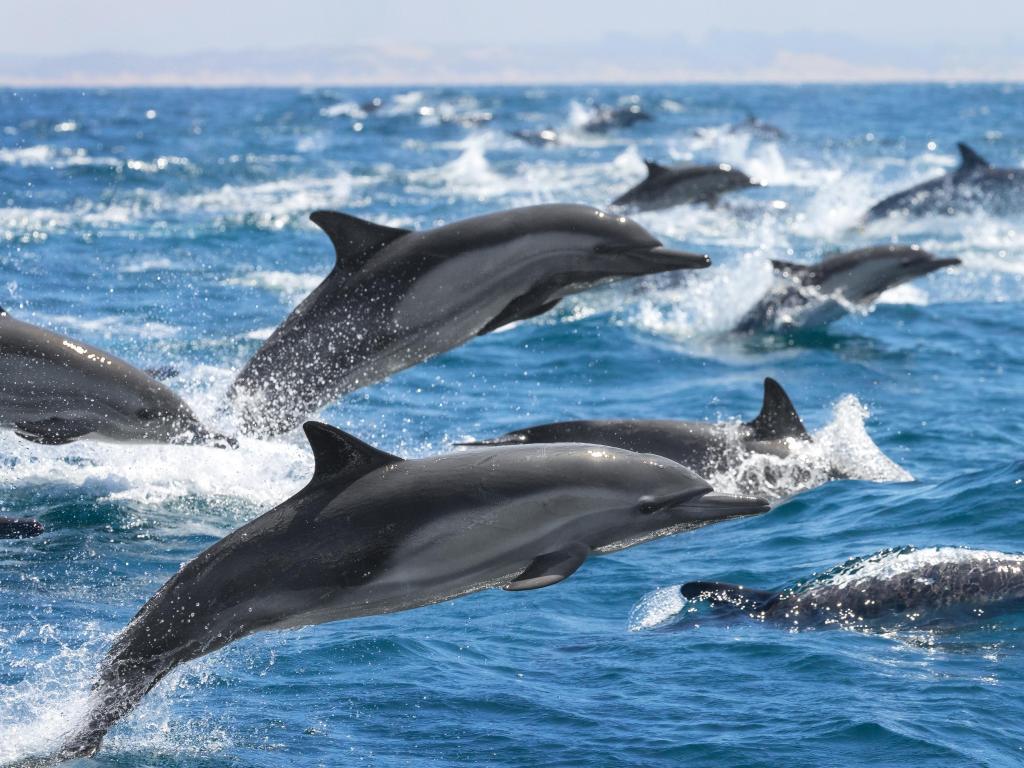
How to get from Yosemite to Monterey and Carmel-by-the-Sea: Leave the park via the South Entrance and hop on CA-49 to travel West past Oakhurst. Switch to CA-140 to arrive at Merced and then head southwest on CA-152 towards the Pacific Coast.
You will merge onto US-101 and the Pacific Coast Highway after driving through Gilroy and arrive shortly at Monterey and then Carmel-by-the-Sea.
What to expect on the drive from Yosemite to Monterey and Carmel-by-the-Sea: The trip from Yosemite to Monterey and Carmel-by-the-Sea is a fabulous drive that transitions from the rugged Sierra Nevada mountains, through valleys and vineyards, before meeting the rolling hills of California's Central Coast.
Your first stop after leaving Yosemite will be Merced, a thriving city which has become a known for its locally owned shops, restaurants and bars. Make sure to explore the Historic Downtown during your visit, with examples of art déco architecture.
For a unique and quirky experience, you can even visit the 'Garlic Capital of the World' on your trip. Gilroy has historic agricultural roots, but nowadays when you head into its restaurants and shops, you're most likely to find garlic-infused cuisine.
Our highlights: The main attraction in Monterey is Monterey Bay Aquarium, considered one of the best in the world, but don't miss out on the chance to explore Monterey's Cannery Row too. This famous historic waterfront street is lined with art galleries, shops, and restaurants.
When you're ready to move on to Carmel-by-the-Sea, we highly recommend taking the scenic 17-Mile Drive. This iconic coastal route features many vistas, golf courses, and the Lone Cypress, a picturesque viewpoint featuring a single tree overlooking the ocean.
Once you've arrived in Carmel-by-the-Sea, spend some time exploring the picturesque village by the water, then head to Carmel Beach to relax on the pristine white sands.
Did you know? From 1986 to 1988, Clint Eastwood was the mayor of Carmel-by-the-Sea.
9. Death Valley National Park
6 hours 20 minutes from Yosemite (350 miles)
Why you should visit Death Valley: The otherworldly landscapes of Death Valley are a stunning contrast to Yosemite's forested slopes and valleys. Famous for its unique terrain and extreme conditions, it's your opportunity to visit the lowest point in North America as well as seeing salt flats, sand dunes and rugged mountains.
Despite the challenging terrain, Death Valley is a popular place for hikers and photographers - but always check for local weather advice and make sure you're fully prepared for your visit. It's also a stunning destination for a scenic drive or an unforgettable stargazing experience.

How to get from Yosemite to Death Valley: Leaving via the South Entrance, head south on CA-41 to reach Fresno. From here, follow CA-99 all the way to Bakersfield and then hop on CA-58.
Switching to CA-14 and then CA-178 past Ridgecrest will take you to Panamint Springs, which you can use as a gateway to Death Valley National Park.
What to expect on the drive from Yosemite to Death Valley: As you drive from Yosemite to Death Valley you'll be exchanging mountain views for scenic desert landscapes, as the Sierra Nevada foothills make way for the Mojave Desert. Prepare for long stretches of desolate highway as you approach Death Valley.
You'll have some urban interludes along the way, including a stop in Fresno to explore the famous Forestiere Underground Gardens and Shinzen Japanese Garden at Woodward Park.
Bakersfield is also worth a visit. You can tour the restored Historic Bakersfield Fox Theater, which dates back to 1930, whilst Buck Owens' Crystal Palace, a must for country music fans.
Our highlights: Visit the Badwater Basin salt flats, and you'll be able to say you've visited the lowest point in North America. The elevation here dips as low as 282 feet below sea level, so when you carry on to Dante's View - perched 5,000 feet above the valley floor - the contrast will be impressive.
Elsewhere in Death Valley, the colorful rock formations and changing landscapes are unforgettable. The surreal Zabriskie Point is especially impressive at sunrise or sunset, whilst a trip along scenic Artist's Drive lets you take in the vibrant hues of the mineral-rich hillsides around the Artist's Palette.
For more inspirational vistas, you can find our ultimate guide on the best photo spots in Death Valley here.
Did you know? Death Valley holds the record for the highest air temperature on Earth. At Furnace Creek Ranch, the temperature reached 134 degrees Fahrenheit (56.7 degrees Celsius) on July 10, 1913. The reading cemented Death Valley's stature as one of the hottest places on the Earth.
READ MORE - Road Trip from Yosemite to Death Valley National Park
10. Sequoia National Park
2 hours 30 minutes from Yosemite (140 miles)
Why you should visit Sequoia National Park: California's towering Sequoia trees are an impressive sight, especially when you consider that among the groves at Sequoia National Park, you'll find the largest tree in the world!
Depending on when you choose to travel and the weather, this will be the shortest drive on our list, allowing you to make the most of the outdoor activities on offer earlier in the day. Once you've completed the drive, there are hiking trails through the groves to suit different abilities.
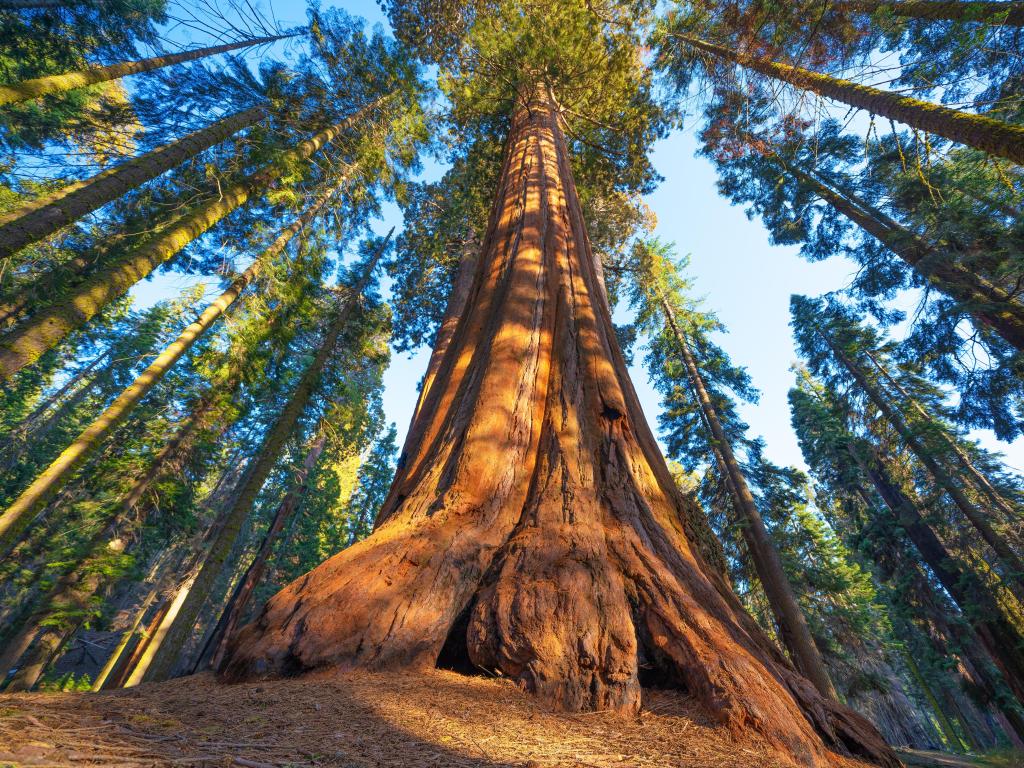
How to get from Yosemite to Sequoia National Park: Use the South Entrance of the National Park as you leave Yosemite and follow CA-41 south to reach Fresno. From here, CA-99 and then CA-198 will take you to Sequoia National Park.
What to expect on the drive from Yosemite to Sequoia National Park: On your way south from Yosemite you'll visit Fresno, a major city in the Central Valley known for the Mediterranean-styled Forestiere Underground Gardens.
From Fresno, you'll begin to ascend into the Sierra Nevada Mountains. The road trip to Sequoia National Park will take you through the foothills and dense forests that continue all the way to the park's entrance.
Towards the end of your drive, take a rest stop at Kaweah Recreation Area. You can enjoy fabulous views of the lake and mountains here, or continue a little further along the road to Slick Rock Recreation Area for more mountain views.
Our highlights: The main attraction at Sequoia National Park is the General Sherman Tree, and few people come to Sequoia without witnessing the extraordinary size of the world's largest tree.
Another quirky experience nearby is Tunnel Log. As its name suggests, you can drive right through this fallen sequoia tree. You'll find this fabulous photo opportunity along Crescent Meadow Road, which is also a great place for a gentle hike through lush green meadows.
To see the giant landscape from a different perspective, climb to the top of Moro Rock. The granite dome offers panoramic views of the surrounding area.
Did you know? Excluding Alaska, Sequoia National Park is home to the highest peak in the United States. Mount Whitney stands at an elevation of 14,573 feet.
11. Lassen Volcanic National Park
7 hours from Yosemite (360 miles)
Why you should visit Lassen Volcanic National Park: As its name suggests, Lassen is famous for its volcanic activity, which makes it a really unique experience and a must-see for geological enthusiasts. When you explore the park you can see fascinating geothermal features such as mud pots and volcanic vents called fumaroles alongside the volcanoes and lava fields.
At Lassen you'll find wildflower meadows and clear mountain lakes, often free of the crowds drawn to other national parks. Over 150 miles of hiking trails wind around the park.
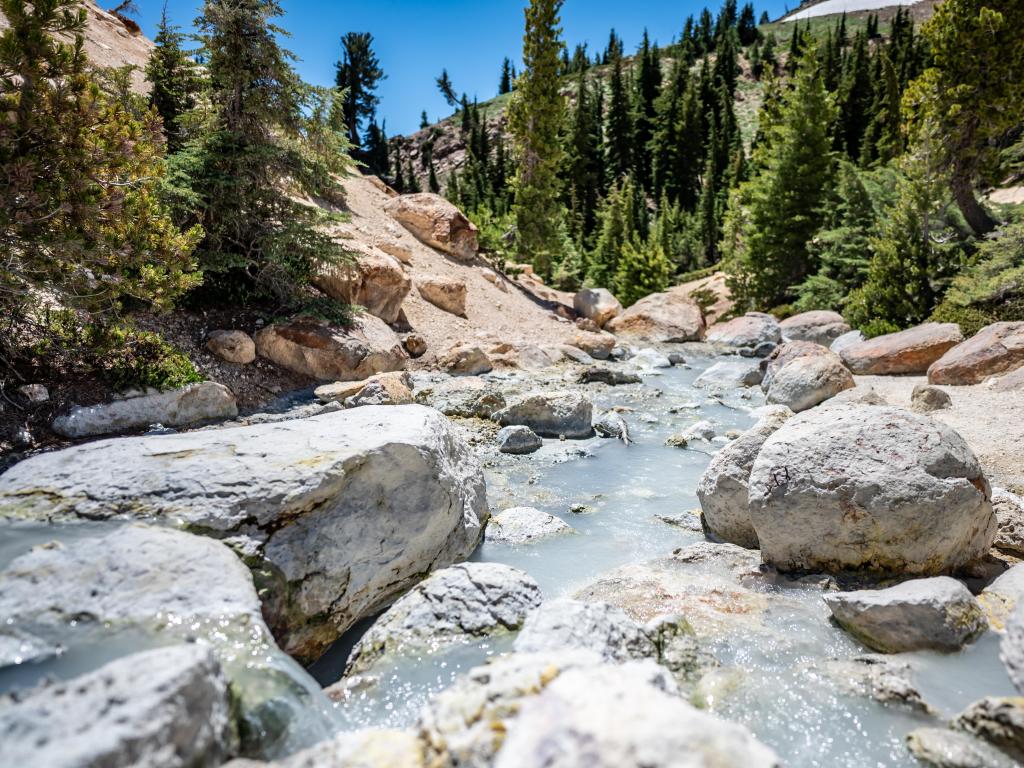
How to get from Yosemite to Lassen Volcanic National Park: Use the Big Oak Flat Entrance to leave Yosemite and head west on CA-120. Driving towards Lake Tulloch, you will hop onto O Byrnes Ferry Road and then CA-4 past Copperopolis.
Keep heading north and merge onto CA-49 past San Andreas. This road will take you to US-50 past Diamond Springs and you will soon drive past shimmering shores of Lake Tahoe. Drive north past Carson City and Reno, and you will soon reach Lassen Volcanic National Park.
What to expect on the drive from Yosemite to Lassen Volcanic National Park: Your road trip to Lassen Volcanic National Park begins with a scenic drive, which wind through the stunning mountain landscapes of Eldorado National Forest.
Next, your drive from Yosemite takes you past Carson City, from where it's just a short detour to visit the stunning shores of Lake Tahoe.
Continuing on towards Lassen Volcanic National Park you'll reach Reno, and we recommend pausing to explore the historic charm of Nevada's state capital.
Known as 'The Biggest Little City in the World', while you're in town you can visit the National Automobile Museum and enjoy the lively entertainment scene.
Our highlights: The largest hydrothermal area at Lassen Volcanic National Park is the impressive Bumpass Hell. You'll find a whole array of geothermal attractions here, including colorful hot springs, boiling mud pots, and steaming vents.
The hydrothermal activity in Lassen Volcanic National Park is an unforgettable experience. If you want to see even more of it, hike the Devil's Kitchen Trail through Warner Valley, which passes mud pots and steam vents.
If you're feeling even more active you can also hike the 5-mile round trip to the summit of the park's largest volcano, Lassen Peak. It's a challenging hike, but with the reward of summit views of the surrounding landscape.
For a more relaxed experience, head to Manzanita Lake and admire the view of Lassen Peak from its shores. You can enjoy picnicking, kayaking, and scenic walks around the tranquil lake.
Did you know? Lassen Peak is home to all four types of volcanoes—shield, plug dome, cinder cone, and composite.

